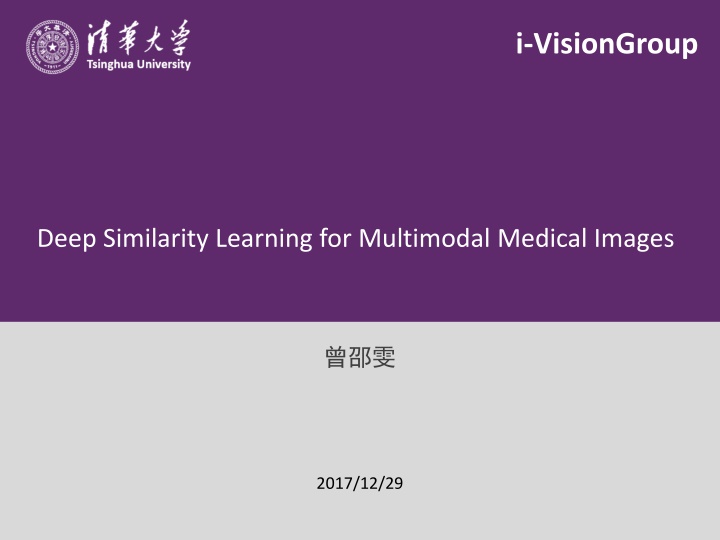
Deep Similarity Learning for Multimodal Medical Images
Explore how deep neural networks are utilized to learn similarity metrics for uni-modal/multi-modal medical images in the context of image registration and clinical applications. Methods such as fully connected DNNs and stacked denoising autoencoders are discussed, emphasizing the importance of effective similarity measures in medical image analysis.
Download Presentation

Please find below an Image/Link to download the presentation.
The content on the website is provided AS IS for your information and personal use only. It may not be sold, licensed, or shared on other websites without obtaining consent from the author. If you encounter any issues during the download, it is possible that the publisher has removed the file from their server.
You are allowed to download the files provided on this website for personal or commercial use, subject to the condition that they are used lawfully. All files are the property of their respective owners.
The content on the website is provided AS IS for your information and personal use only. It may not be sold, licensed, or shared on other websites without obtaining consent from the author.
E N D
Presentation Transcript
i-VisionGroup Deep Similarity Learning for Multimodal Medical Images 2017/12/29 i-VisionGroup
Introduction An effective similarity measure for uni-modal/multi-modal medical images is important in many clinical applications such as image registration. statistics-based metrics: mutual information, K-L divergence supervised learning metrics 2 i-VisionGroup
Introduction DNN (deep neural network): Classification, detection: An image/patch is sent directly into a DNN classifier. Learning similarity between images: More difficult. - concatenation of two images - learning objective 3 i-VisionGroup
Methods 1. Similarity metric learning a fully connected DNN Input: CT and MR image pairs Output: state of correspondence 4 i-VisionGroup
Methods 1. Similarity metric learning 5 i-VisionGroup
Methods 2. DNN Pre-training stacked denoising autoencoder 6 i-VisionGroup
Autoencoder(AE) encoder = + ( ) h f Wx b 1 m m decoder m x f W h = + T ( ) b x 2 m m objective M 2 argmin W b b = + + T { , , } W b b ( ( ) ) f W f Wx b b x 1 2 1 2 m m 2 = 1 m , , 1 2 D + ( ) KL j = 1 j 7 i-VisionGroup
Stacked Denoising Autoencoder Denoising Autoencoder (DAE) It is trained ro reconstruct a clean ersion of noisy input. Stacked Denoising Autoencoder (SDAE) Trained separately in a layer-wise manner. 8 i-VisionGroup
Methods 2. DNN Pre-training multi-model SDAE 9 i-VisionGroup
Methods 2. DNN Pre-training The training results from SDAE can be used to initialize the bottom three layers (L1-L3) of DNN. 10 i-VisionGroup
Experiments 1. Training Data Positive samples: Sampled from patches centered in or around skulls. Negative samples: Ramdomly sample negative MR patches once for each CT skull patch in the positive set. 2000 matched pairs and 2000 unmatched pairs. 2D patches: 17*17 11 i-VisionGroup
Experiments 2. Settings DNN: 5 layers: 578 578 300 100 2 Toolbox: Implemented in Matlab Timing: 30 min for training on a Quad-Core processor maching. 12 i-VisionGroup
Experiments 3. Similarity Metric Evaluation Randomly select 300 patches, and compute similarity scores in the 81*81 neighborhood. Compute the rank ? of the highest score in the 3*3 region. Prediction error: ? = ? 1 13 i-VisionGroup
Experiments 3. Similarity Metric Evaluation 14 i-VisionGroup
Future work Extend the proposed similarity metric from 2D to 3D. Incorporate it into nongrid registration framework for further evaluation. 15 i-VisionGroup
Other work unsupervised learning metrics 16 i-VisionGroup
Convolutional Stacked Autoencoder Stacked Autoencoder (SAE) AE 17 i-VisionGroup
Convolutional Stacked Autoencoder Convolutional SAE 3D 2D 1 Pv Lv * Lv Pw Lw * Lw Lv - Lw+1 * Lv - Lw+1 =N N SAE N N/9 18 i-VisionGroup
